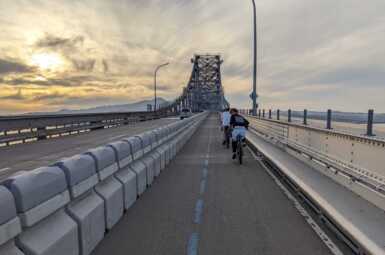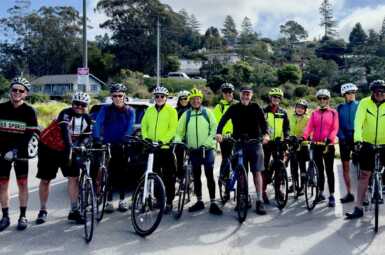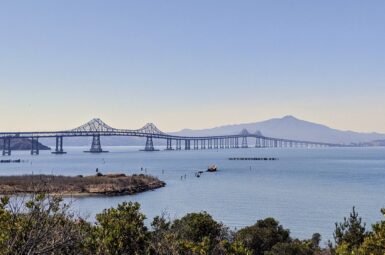November 2020 Election San Anselmo Town Council Candidate Questionnaires
As a 501(c)3 nonprofit organization, Marin County Bicycle Coalition cannot endorse candidates for public office, but we are able to share information so that you can arrive at your own conclusion. Below are San Anselmo candidates’ responses to our questionnaire on bicycling in Marin. We have made no content changes. Thanks to the candidates for their time and thoughtful answers!
Here are the five candidates vying for three seats on the San Anselmo Town Council:
Brian Colbert, Alexis Fineman, John Wright, Ann Politzer, Eileen Burke
Do you ride a bicycle? If so, for what purposes and how often? (transportation/road/mtb)
Brian Colbert:
-
Commuting/Errands: 2-3 days per week
-
Road: 2-3 days per week
-
Mountain: 0-1 days per week
Alexis Fineman:
-
Commuting/Errands: 4+ days per week
-
Road: Never
-
Mountain: Never
John Wright: No response.
Ann Politzer: No response.
Eileen Burke:
-
Commuting/Errands: 2-3 days per week
-
Road: 2-3 days per week
-
Mountain: 2-3 days per week
Where does improving bicycling infrastructure and safety rank among your other policy priorities (HIGH / MODERATE / LOW / OTHER)
Brian Colbert: High
Alexis Fineman: High
John Wright: No response.
Ann Politzer: No response.
Eileen Burke: High
What’s your vision for the future of transportation in San Anselmo? What are some of the town’s challenges, and how would you go about fixing them?
Brian Colbert:
Bicycle and pedestrian safety are among my top priorities. San Anselmo’s top challenges involve address the immediate short-term and long-term challenges stemming from COVID19. I spearheaded, Reimagine Creek Park which created a commons in San Anselmo’s historic downtown. This coupled with my initiative to successfully close the streets in the evenings encourages multi-modal travel to downtown and throughout San Anselmo.
Alexis Fineman:
My vision for the future of transportation in San Anselmo is my vision for the future of transportation, period. Though cars aren’t going away anytime soon, we need to decrease our dependency on cars and increase the viability and use of alternative ways of getting around. Bicycles are absolutely critical on this front, especially cargo and electric bicycles. There are many reasons why people don’t bike more in San Anselmo – topography and infrastructure (or lack of, and ensuant safety concerns) among them. However, with changes in circulation and commute patterns and the rise in remote/flex work and an increasing number of ebikes, it really comes down to infrastructure, and that is something the town has almost exclusive control over.
Our streets are clearly optimized for cars and car storage. One challenge is that any changes to the status quo, even if they result in balanced compromise, will be perceived of as taking away, even though in the long term viable transportation alternatives benefit drivers, too. So, one challenge is knowing how and where to navigate various tradeoffs, which takes some political courage. Another challenge is funding — though grants can and do play a critical role here. And finally, there need to be stronger standards of what “infrastructure” entails…it’s more than just sharrows…. Bringing stakeholders from all transportation and circulation sectors together and including all perspectives at the outset (not as an afterthought) is critically important to addressing these and other challenges.
John Wright: No response.
Ann Politzer: No response.
Eileen Burke:
I believe our future will be electric and then fuel cell cars and public transportation. As we move to electric we need to assist residents by installing charging stations in our commercial areas. We aren’t there yet, but I anticipate gas stations will eventually be fuel cell stations. These moves away from fossil fuel are clean, cheaper, and they reduce our dependence on foreign oil.
San Anselmo has always been a biking town. I have been riding my bike in San Anselmo since I was 5 years old (for 50 plus years). We’ve become a mountain biking mecca and road riders regularly utilize our roads. We are also seeing more and more electric bikes for short errands, transporting kids and that allow many residents an enjoyable biking experience they might not otherwise be able to have (ie getting up our steep hills). Many of our residents commute with public transportation by taking buses and/or the ferry. I expect this will remain relatively flat through the future although Covid has shown us that companies are adapting to the ability to work at home and so it is possible long distance commuters may actually decrease in the future in favor of at home or regional work center work. Some of the challenges facing San Anselmo on the bike front have to do with our narrow streets that were not designed for bike lanes. We lack the space to widen most of these streets without completely removing the ability to park a car on the street. My approach is to designate bike routes, safe routes to school and clearly mark sharrow lanes. I’d also educate the public about them, work with the CMPA and biking organizations to enforce sharing of the streets by bikes and cars, and most importantly, I am for limiting all of our residential streets that are not main arteries (SFD Blvd, Butterfield, Center, Red Hill) to a 15 or 20 mph speed limit. This would make our streets much safer for bikers, walkers, pets and drivers. Most of our residents live within 1 mile of a main artery, so the impact on driving time would be negligible but it would improve our quality of life significantly.
Covid-19 has dramatically impacted transportation, with fewer cars on the road, but also fewer people riding transit. How will you work to ensure that recovery efforts include sustainable and equitable transportation outcomes, especially for those most reliant on transit?
Brian Colbert:
As a member of the Transportation Authority of Marin and a Director of Marin Transit, I am working hard to address the financial and operational challenges stemming from Covid-19. Unfortunately, essential workers and the most vulnerable members of our community are the most likely effected by the public transportation’s difficulties. I am working to find a fiscally sustainable mode for public transportation that can bend the climate curve.
Alexis Fineman:
As a councilmember, I recently advocated for sustainable recovery when the town was considering a quick-build program to turn downtown San Anselmo into a one way street for widened sidewalks and parklets. Bikes were treated as an afterthought. (This is despite our grant application checking the box for enhancing bike protections.) Despite everyone talking about wanting bike and ped safety, no other councilmembers took issue with the design as it was initially proposed. I was instrumental in convening stakeholders and ultimately setting an alternative plan in motion, a plan which included a protected contraflow bike lane with protective striping rather than a cockamamie detour with unprotected turns and car traffice. The tradeoff would have been some parking spaces downtown. These are usually at a premium, but our parking needs are significantly lower than usual, so to me it made sense to take an overallocated resource (parking spaces) and use it to meet an under-resourced need (bike protections). Ultimately, the decision to do anything was postponed until spring, at which point I plan to advocated strongly for bike infrastructure..
The transit piece is really tricky; my work on the Town Council has so far had no real overlap with transit authorities (except writing and getting council approval to send a letter requesting that e-bikes be allowed on the Larkspur Ferry). In general, for issues like this, which are not limited to San Anselmo, I like to look at what other cities and towns are doing to address similar issues in their jurisdictions. We’re not the only ones facing questions about what transit looks like in the future. Understanding the options and decisions of others is immensely helpful. Prior to Covid, something I and our Sustainability Commission had been talking about was installing bike lockers for the Hub and Butterfield at the bus stops to encourage two-wheeled first/last mile connectivity.
John Wright: No response.
Ann Politzer: No response.
Eileen Burke:
Covid has caused layoffs and route cuts to public transportation that have undoubtedly impacted some San Anselmo residents who are reliant on public transit. I anticipate these routes will return once we end the pandemic. In the meantime, biking, utilizing smaller coaches rather than large buses, encouraging ride sharing, putting commuters together, promoting Uber and Lyft rides, and use of private cars will fill the void. Subsidizing public transportation on a regular or mass scale is beyond the scope or budget of the San Anselmo Town Council and is a regional problem.
If elected, what would you do to 1) improve safety for all people who ride bikes and 2) increase the number of people who bike for transportation? Please note any infrastructure projects in San anselmo that you think are particularly important.
Brian Colbert:
1) I’m member of the San Anselmo Safe Routes to School Task force. I feel encouraging children to walk and bike to school at a young age provides embeds skills that stay with with them over their whole lives. 2) Increasing bike safety in San Anselmo and Marin encourages people to uses bikes for short trips within Marin County. Getting people to take short bikes within Marin County seems a feasible short-term goal that can be achieved within the fiscal challenges that cities and towns are currently experiencing. The residents of San Anselmo love the closed downtown streets. It is important to continue to iterate the program.
Alexis Fineman:
These two questions overlap substantially; therefore, so do my answers.
Improving safety: We are one of a handful of jurisdictions in the county without our own protected bike lane(s)! I’ve lived within a mile of downtown San Anselmo practically my whole life, and I was not allowed to bike downtown while growing up due to the lack of bike infrastructure and protections (I biked downtown once between ages 0-22!) Over the last four years, as cycling (including e-biking) has become my primary mode of transportation, I remain acutely aware of the safety concerns that many families as well as new or casual cyclists have. Especially now that ebikes are “leveling” our county’s hills, safety concerns and inadequate infrastructure are some of the main remaining barriers to adoption. I understand firsthand how insufficient sharrows are – I will push for striping, pylons, and real protections for cyclists.
Increasing cyclists: As stated above, we need to be clear on what the current obstacles are, and which of those fall within the scope of the town’s authority to address. As mentioned before, topography, practicality (can I bike with my groceries, kid, etc), and safety are key barriers. I think the changes in technology (more cargo and ebikes) and the economy (more work-from-home and local, outdoor living) help address some of those barriers and increase bike adoption. However, the safety piece really comes down to infrastructure. Cycling infrastructure doesn’t need to be fancy or engineered to be successful; rather, it is only as good as its weakest link or biggest gap. Countries like Sweden and cities like Copenhagen have incredible continuous bike routes, and the results speak for themselves. Here, it feels like continuity is an afterthought rather than a component critical to success. I was shocked at how terrible the connection to the Richmond Bridge is on the San Rafael side! I think there’s a number of things we can do. First, we can strengthen and localize our “complete streets” policy to move beyond “sharrows.” Sharrows are not bike infrastructure, and we shouldn’t pat ourselves on the back for painting them. Actual protections and separations should be elevated and considered in all public road projects.
This year, we’ve approved funding to work on a “bike spine” project for streets near schools. We’ve also approved funding and begun the process of rehabilitating SFD Blvd between the Hub and Bolinas. This area is ripe for some enhanced bike protections, and some have been outline in our Bicycle and Pedestrian Master Plan.
John Wright: No response.
Ann Politzer: No response.
Eileen Burke:
As mentioned above, my approach is to designate bike routes, safe routes to school and clearly mark sharrow lanes. I’d also educate the public about them, work with the CMPA and biking organizations to enforce sharing of the streets by bikes and cars, and most importantly, I am for limiting all of our residential streets that are not main arteries (SFD Blvd, Butterfield, Center, Red Hill) to a 15 or 20 mph speed limit. This would make our streets much safer for bikers, walkers, pets and drivers. Most of our residents live within 1 mile of a main artery, so the impact on driving time would be negligible but it would improve our quality of life significantly.
I would also promote the use of bike safety devices such as helmets, bright vests, lights, mirrors, bells, flags and hand signals.
Increasing the number of people who bike for transportation will follow from a safe, supported bike environment as outlined above. Making bike racks readily available would also help. Electric bike promotion through “try it” events would likely also increase the numbers who bike for transportation.
Why should people who ride bikes vote for you?
Brian Colbert:
I’ve consistently supported the Marin County North-South Greenway while serving as a Commissioner of TAM over the last 3 years. I also use bicycles in my personal life. I have a mountain bike. I also have an electric bike which I used to commute in SF one day a week before the advent COVID-19. I have been a strong advocate for bicycles and bicycle safety as a councilmember in San Anselmo and as a Commissioner of the Transportation of Authority of Marin. Finally, last spring I spent eight days of my personal time in the Netherlands on a mobility study. We never set foot in a car the whole trip, only biking, walking, or using the train. I was even lucky enough to make it to the Hovenring, a floating bicycle roundabout. I’ve been using that experience to information the possibilities in San Anselmo and in Marin County.
Alexis Fineman:
I’m a cyclist, and I’m passionate about sustainability and transportation!
John Wright: No response.
Ann Politzer: No response.
Eileen Burke:
I am an avid cyclist and member of MCBC. Biking is my primary means of exercise and running local errands. I have a mountain bike, an electric bike and a Peloton — I’m on one or more of these every day. I biked to school in San Anselmo since I was 6 years old and my kids did the same, so I understand the importance of safe routes for kids. I’ve ridden from SF to LA in the California Aids Ride and I’ve ridden many centuries in California so I’ve experienced the challenges of riding with cars whizzing within inches of me. I mountain bike and have first hand knowledge of the hostility that can occur between hikers (which I also am) and mountain bikers. I am very attuned to the needs and challenges of bikers of all types. I support educating bikers and car drivers on bike safety. I believe promoting biking, bike infrastructure and bike safety is very important and it is a priority for me.
members make it happen!
We’re fighting for a more bike-friendly future in Marin. Are you with us? Join Marin County Bicycle Coalition today.



